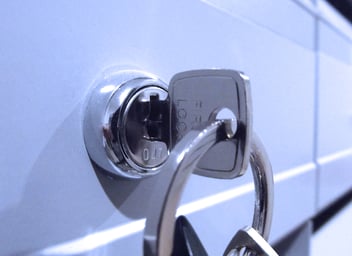How Often Should You Change A Commercial Master Key Lock?

Your building holds some of your business's most valuable assets, even the human ones. (If you aren't securing it properly, we need to talk). When keys fall into the wrong hands or one is lost, it can be a financial burden. Not just for replacing the contents of the building or digital property, but the cost of replacing every lock and key can be costly and time-consuming. Investing in a Master Key System can protect your building and save you money over time. However, you can't just install the locks, distribute the keys and forget it. There are circumstances that warrant changing a master key lock to ensure your assets remain secure.
In this article, we’re going to discuss:
- What is a Master Key System
- The Importance of Having a Master Key System
- The Hierarchy Levels in a Master Key System
- Reasons to Change a Commercial Master Key Lock
What is a Master Key System?
Let's start with the basics and understand what a master key system is and how does it work. An essential part of the system is the lock itself.
A master key lock is door hardware that can be an interchangeable core (standard key core) or a conventional lock. The difference between the two is the key system the key core is a part of. An interchangeable core that is pinned for master key access will only open for a single key cut that interacts with the correct pins. An interchangeable core that is part of a master key system will open for a user key and for a master key.
A master key system is a group of locks, including all the keys that operate them. They are related in a hierarchy with one key at the top level; and a large number of keys at the bottom level, which may only fit into one lock. Designated keys can open a number of pre-defined doors. A Master Key System works by establishing a multi-tiered security framework. The fewer master key levels, the more secure the system. This hierarchy enables you to allow access to certain areas of your business to authorized personnel.
The Importance of Having a Master Key System
Every facility and business has unique needs for key security. There are a lot of factors to take into consideration that determines the level of security you require. One of the benefits of a master key system is that it is scalable as your business grows.
- Master key systems are created on restricted keyways, which are serialized keys that can't be duplicated without authorization. Keys in restricted key control programs carry unique serial numbers that enable you to be able to identify individual keys within the locking system. Each unique serial number can be used to track keys to their individual holders and also provide information about the key and the areas of your system it can access. This information enables you to track your keys 24 hours a day, seven days a week, with cloud-based key tracking software. The birth-to-death tracking provided by master key serialization ensures you always know how many keys exist, who holds them, and the level of access each key provides.
- The financial benefits of commercial rekeyable locks far outweigh the upfront cost of a master key system. It is cheaper to rekey a lock than replace a lock. You won't have the added expense of calling a locksmith or the possible lost time while waiting for the locksmith to show up. You also will avoid having to purchase and provide new keys to those who need access to that portion of the building. If a master key is lost and your building has 200 locks, the cost to replace 200 traditional locks can be staggering.
The Hierarchy Levels in a Master Key System
Most master key systems have between two and four levels of access. The key is to structure your levels around your buildings, not your personnel, by defining departments, buildings, or geographic areas. Here is an overview of the four levels of keys in a master key system:
Great Grand Master Key: The highest level of master key access. This key is used in hierarchies requiring many tiers of access. It's recommended that great grand master keys be very limited in distribution as they grant the highest level of access to an organization. They are often utilized in large, multi-site organizations with multiple facilities.
Grand Master Key: A grand master key is used in hierarchies that include multiple locations or buildings. These keys can also open any doors fitted with an associated master key lock and offer a higher level of access than a master key.
Master Key: Can open all locks at or below the master key level in the system but cannot open locks that are pinned at the great grand or grand master key level. They are created on restricted keyways. Master keys should be distributed to as few key holders as possible to minimize security breaches. A master key may be the highest level of access needed for single-location companies.
User Key: The base level of access into your organization as a standard key for distribution that can only open a single lock. User keys are an essential part of the master key hierarchy. Anyone who doesn't need master key level access but needs more limited entry should be assigned a user key.
Reasons to Change a Commercial Master Key Lock
Best practice for building security is to rekey locks whenever there is reason to believe that there is a risk. When it comes to your personnel, trust only goes so far, especially when it comes to site keys. The higher up the hierarchy, the higher the risk if a key has been compromised. As we explained above, keys on a non-restricted master key program can be duplicated by a locksmith, home improvement center, or even a key machine. You would have no idea if your five keys turned into ten keys without your authorization. The difference between a master key and a user key is that all locks under the master key are affected versus a key that just gets into a single door or group of doors. Here are some situations that warrant immediate attention when it comes to changing commercial master key locks that are not on a restricted key program.
- An employee termination of a master key holder that wasn't on the best of terms.
- External contractors have been provided a master key.
- An employee lost a master key, or it was stolen.
- Someone gained access who isn't authorized.
- A key audit identifies a missing master key.
With these and any other at-risk situations, all locks under the master level should be changed.
For master key locks that are on a restricted master key program, if all keys have been tracked and accounted for, the lock itself shouldn't need to be changed until it fails.
Visit our Key Management Systems Resources page for more information on how Instakey can provide a solution for your facility's security needs.





